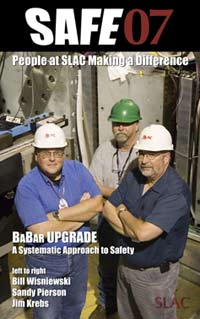
Handy Links
SLAC News Center
SLAC Today
- Subscribe
- Archives: Feb 2006-May 20, 2011
- Archives: May 23, 2011 and later
- Submit Feedback or Story Ideas
- About SLAC Today
SLAC News
Lab News
- Interactions
- Lightsources.org
- ILC NewsLine
- Int'l Science Grid This Week
- Fermilab Today
- Berkeley Lab News
- @brookhaven TODAY
- DOE Pulse
- CERN Courier
- DESY inForm
- US / LHC
SLAC Links
- Emergency
- Safety
- Policy Repository
- Site Entry Form

- Site Maps
- M & O Review
- Computing Status & Calendar
- SLAC Colloquium
- SLACspeak
- SLACspace
- SLAC Logo
- Café Menu
- Flea Market
- Web E-mail
- Marguerite Shuttle
- Discount Commuter Passes
-
Award Reporting Form
- SPIRES
- SciDoc
- Activity Groups
- Library
Stanford
Around the Bay
SAFE '07 Success Story: 2006–2007 BaBar Upgrade Team
 Last winter, the BaBar detector stopped humming for four months to undergo its most complex upgrade to date. Several hundred vacuum specialists and machine physicists, accelerator technicians and riggers, surveyors and others worked in up to three shifts a day to conduct this complicated, detailed work. Some of the activities entailed significant safety challenges including complex rigging operations, working under aggressive schedules, engaging in physically demanding activities in sometimes congested work spaces and working at heights. Despite the numerous challenges presented, the upgrade was successfully completed without a single safety incident.
Last winter, the BaBar detector stopped humming for four months to undergo its most complex upgrade to date. Several hundred vacuum specialists and machine physicists, accelerator technicians and riggers, surveyors and others worked in up to three shifts a day to conduct this complicated, detailed work. Some of the activities entailed significant safety challenges including complex rigging operations, working under aggressive schedules, engaging in physically demanding activities in sometimes congested work spaces and working at heights. Despite the numerous challenges presented, the upgrade was successfully completed without a single safety incident.
"Management of the risk associated with this project has been accomplished by taking a systematic approach to safety from the very beginning," said Frank O'Neill, Environment, Safety and Health Coordinator for the Particle and Particle Astrophysics Directorate. "Many talented people expended a great deal of effort to ensure that safety was an integral part of all phases of this operation". Jim Krebs, BaBar's Chief Engineer, Safety Team Leader Sandy Pierson, and Bill Wisniewski, BaBar Technical Coordinator, were key in leading this effort.
Jim Krebs, along with collaborators from Princeton and Italy, began planning for the BaBar upgrade in January of 2003 and was responsible for the engineering of all hardware, the master schedule, and the development of procedures. The very first stages of the upgrade included taking into account lessons learned from previous downs and creating detailed plans for every major movement of equipment. Identifying, evaluating, and addressing risk began at the very beginning of this planning process. Krebs was also in charge of running the day shift—safety/coordination meetings. Bill Wisniewski ran the swing shift—safety/coordination meetings. These "tailgate" safety/coordination meetings were attended by at least one person from every activity that would be performed that day. Strict coordination and authorization of all activities was crucial to ensure all working groups were on the same page for each shift. Due to the volume of activities and the multiple crews working simultaneously, without this kind of control and communication there was a real potential for chaos. "These meetings ensured that everyone knew what everyone else would be doing and approximately when they would be doing it," said Krebs. "They allowed for anything new that came up that day to be dealt with before any work began."
Sandy Pierson complemented Kreb's work by developing a safety plan that presented an organized approach for tailoring the safety effort. One of the features of the plan was the creation of a safety team. The role of the safety team was to provide 100% safety oversight; by directly assisting supervisors with optimizing safety in day to day activities; by communicating safety issues and lessons learned at the shift safety/coordination meeting; by providing training; and calling upon safety experts when required. The safety team was not there to take the place of the supervisor.
"There were many people trying to get as much done as possible in a short amount of time in a congested area," said O'Neill. "By creating the expectation of safety, we kept this project injury free."
"A strong safety culture has developed in the BaBar collaboration over the life of the program," added Wisniewski. "All of the teams and crews that participated in this activity fully accepted the BaBar approach to safety and all of these individuals deserve credit for safely completing this major upgrade."
—Kelen Tuttle and Frank O'Neill, SLAC Today, May 15, 2007